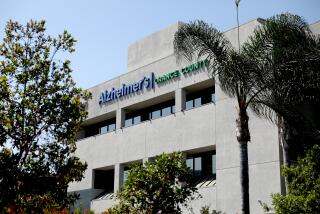Bone drug may reduce mortality
- Share via
Yearly infusions of the bone-strengthening agent zoledronic acid in elderly people who have suffered a hip fracture reduced deaths by 28% and new fractures by 35% over a two-year period -- the first time any treatment has been shown to reduce mortality in such patients.
Researchers reported in May that the drug, sold under the brand name Reclast by Novartis, significantly reduced the incidence of fractures in patients with osteoporosis. But the new trial is the first to study people who have already suffered a fracture, said Dr. Dennis Black of UC San Francisco, who was not involved in the study.
The results were “powerful and compelling,” and the study “clearly establishes the need for pharmacologic intervention in patients who fracture a hip,” pharmacologists Karim Anton Calis and Frank Pucino of the National Institutes of Health wrote in an editorial, which accompanied the study that is to appear in the Nov. 1 issue of the New England Journal of Medicine.
The report was published online Monday to coincide with a presentation of the results at a Honolulu meeting of the American Society of Bone and Mineral Research.
About 300,000 elderly Americans are hospitalized yearly with hip fractures, and the outcome can be devastating. As many as 25% of the victims die within the first year after their injuries, the survivors’ risk of subsequent fractures is as much as 10 times higher than normal, and the majority of the victims remain confined to nursing homes for the rest of their lives.
Dr. Kenneth W. Lyles of Duke University Medical Center and his colleagues studied 2,127 men and women -- mostly women -- with a mean age of 74 who had suffered hip fractures without other major trauma. Half were given 15-minute infusions of zoledronic acid within 90 days of their injuries and again at the end of a year, and the rest were given a placebo.
Those who received the drug were unwilling or unable to take oral bone-strengthening agents in the same class, such as Fosamax, Actonel and Boniva. All are bisphosphonates, which bind to cells in bones and prevent them from breaking down bone tissue.
The oral drugs, which are given weekly, monthly or every three months, can cause nausea and erosion of the esophagus. They must be taken on an empty stomach with a full glass of water, and the patient must remain upright for a full 30 minutes after taking them.
The infusion of zoledronic acid is thus easier for elderly patients and requires fewer trips to the doctor.
Soon after the study began, the researchers found that the majority of the subjects suffered vitamin D deficiency and all patients were given a strong dose of the vitamin before receiving drugs. Patients were allowed to receive other therapeutic drugs at the discretion of their physicians, but few did.
After nearly two years, 13.9% of those receiving a placebo suffered new fractures, compared with 8.6% of those receiving zoledronic acid, a 35% reduction. And 141 of those receiving a placebo died of any cause, compared with 101 of those receiving Reclast, a 28% reduction.
The reduction in deaths may arise in part because of the reduced rate of new fractures, but the overall reasons are not fully understood, Lyles said.
The principal side effects -- fever, and bone and muscle pain -- occurred in about 15% of the patients in the days after the injection, though the side effects could be easily managed with acetaminophen and other pain relievers, Lyles said.
Unlike the previous study of zoledronic acid in osteoporosis patients, the team found no evidence for an increased risk of atrial fibrillation, a condition of abnormal heart rhythm.
“If that was a problem, we would have expected more cases in these patients because they are older,” Black said. “That’s reassuring about the safety.”
Some critics have charged that the study’s design bordered on the unethical because patients in the control group were given placebos.
But Lyles and the writers of the editorial said that in general, few patients receive treatment to avert future fractures. In this study, they noted, fewer than 12% of patients received any other therapy from their physicians, possibly because the doctors are unaware of the benefits.
The study did not address quality-of-life issues or confinement of patients to nursing homes after their injuries.
The study was sponsored by Novartis and all of the researchers have received grants or other support from pharmaceutical companies.
Reclast was approved by the Food and Drug Administration last month for treatment of osteoporosis. Zoledronic acid is also sold by Novartis under the brand name Zometa for treatment of Paget’s disease -- a genetic disorder in which bone becomes soft and breaks down easily -- and the prevention of bone loss in cancer chemotherapy.
--






